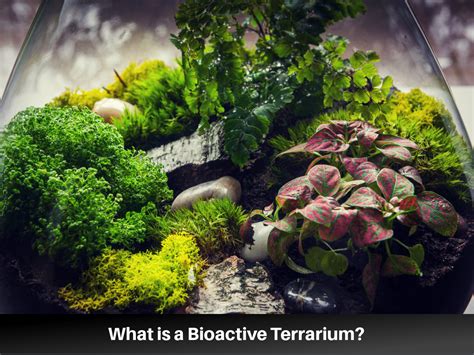Introduction
Bioactive terrariums are self-sustaining ecosystems that provide a natural and healthy environment for plants and animals. They are a popular choice for reptile and amphibian keepers, as well as for those who enjoy gardening. One of the most important factors in maintaining a successful bioactive terrarium is temperature.

The Importance of Temperature for Flowering
Different types of plants have different temperature requirements for flowering. Some plants, such as orchids, require warm temperatures to flower, while others, such as begonias, prefer cooler temperatures. If the temperature in the terrarium is not correct, the plants will not flower or may even die.
Bioactive Terrarium Temperature Guidelines
The ideal temperature range for a bioactive terrarium will vary depending on the type of plants and animals that are housed in it. However, there are some general guidelines that can be followed:
- For plants that require warm temperatures (75°F – 85°F), the terrarium should be heated with a basking spot or heat lamp.
- For plants that prefer cooler temperatures (65°F – 75°F), the terrarium can be placed in a location that receives indirect sunlight.
- For plants that require a wide range of temperatures, the terrarium can be divided into different zones with varying temperatures.
How to Monitor Temperature in a Bioactive Terrarium
There are a few different ways to monitor the temperature in a bioactive terrarium:
- Digital thermometer: A digital thermometer is the most accurate way to measure the temperature in a terrarium. It can be placed in the center of the terrarium or in a specific location where the temperature needs to be monitored.
- Infrared thermometer: An infrared thermometer can be used to measure the surface temperature of objects in the terrarium. This is useful for determining the temperature of basking spots or heat lamps.
- Hygrometer: A hygrometer measures the humidity in the terrarium. While it does not directly measure temperature, it can be used to infer the temperature, as humidity and temperature are closely related.
Maintaining Proper Temperature in a Bioactive Terrarium
There are a few different ways to maintain proper temperature in a bioactive terrarium:
- Heating: If the terrarium needs to be heated, this can be done with a basking spot or heat lamp. The wattage of the heating device will need to be adjusted depending on the size of the terrarium and the desired temperature.
- Cooling: If the terrarium needs to be cooled, this can be done by placing it in a location that receives indirect sunlight or by using a cooling fan.
- Insulation: Insulating the terrarium will help to maintain a consistent temperature. This can be done by using a terrarium cover or by placing the terrarium in a room that is not subject to large temperature fluctuations.
Conclusion
Maintaining proper temperature is essential for the success of a bioactive terrarium. By following the guidelines in this article, you can create a thriving environment for your plants and animals.
FAQs
Q: What is the ideal temperature range for a bioactive terrarium?
A: The ideal temperature range for a bioactive terrarium will vary depending on the type of plants and animals that are housed in it. However, most bioactive terrariums should be kept between 75°F and 85°F.
Q: How can I monitor the temperature in a bioactive terrarium?
A: There are a few different ways to monitor the temperature in a bioactive terrarium, including using a digital thermometer, an infrared thermometer, or a hygrometer.
Q: How can I maintain proper temperature in a bioactive terrarium?
A: There are a few different ways to maintain proper temperature in a bioactive terrarium, including using heating devices, cooling fans, and insulation.
Q: What are the consequences of not maintaining proper temperature in a bioactive terrarium?
A: Not maintaining proper temperature in a bioactive terrarium can lead to a number of problems, including plant death, animal death, and mold growth.
Reviews
Review 1
“This article was very helpful! I was having trouble maintaining the proper temperature in my bioactive terrarium, but after reading this article, I was able to make some simple changes that made a big difference.”
Review 2
“I’m a beginner when it comes to bioactive terrariums, and this article was a great resource for me. It helped me understand the importance of temperature and how to monitor and maintain it.”
Review 3
“This article is very well-written and informative. I highly recommend it to anyone who is interested in bioactive terrariums.”
Review 4
“I’ve been keeping bioactive terrariums for years, and I still learned a few new things from this article. It’s a great resource for both beginners and experienced hobbyists.”





















